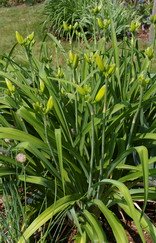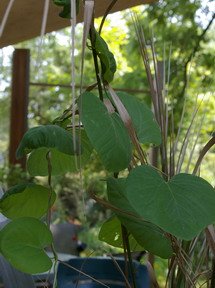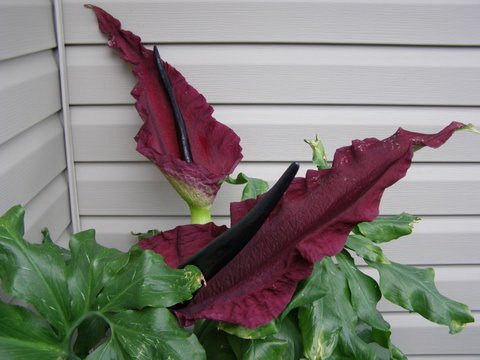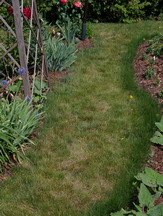

|
They all came and walked and talked. The garden tour was a great success and the garden has never looked better. Monday morning and I stood in the middle of the garden and didn’t know what to do; it all looked so well groomed and complete. Then I realized that vast chunks of the garden had not seen water for quite some time, 2 - 3 weeks since the last rain of significance, so I started dragging hoses and sprinklers. It’s important to get the sprinklers running at the correct time of day. I operate mine between 6 and 9 in the morning or between 8 - 11 at night. The morning is the best. Using sprinklers that throw water up into the air, when the sun is hot and bright just causes too much of that air borne water to evaporate before it ever reaches a plant’s roots.  The Daylily collection is throwing up hundreds of scapes, (that’s the 5 cent horticultural term for a separate flowering stem,) and I’m looking forward to the first bloom. It’s usually on William E Davis but a red Richard is giving it a run for it’s money this year. We added a few new ones last summer, (surprise, surprise,) but I doubt if any of them are going to rush into bloom. A couple do have scapes emerging but not quickly.
The Daylily collection is throwing up hundreds of scapes, (that’s the 5 cent horticultural term for a separate flowering stem,) and I’m looking forward to the first bloom. It’s usually on William E Davis but a red Richard is giving it a run for it’s money this year. We added a few new ones last summer, (surprise, surprise,) but I doubt if any of them are going to rush into bloom. A couple do have scapes emerging but not quickly. It’s always interesting to see what the new ones look like in my own garden. Sometimes they can be quite different from what I thought I purchased. Different light, different soil. The joy of daylilies: they bloom after the Iris are finished, they last for over a month and they are really quite problem free. If only they had some fragrance! It’s time to sow some seeds again. New lettuce needs to be started to fill in the gaps as we eat up the original. The cole crops, Broccoli, Cauliflower, Kohl Rabi - do really well in the cool fall weather and they should be seeded now and planted out in a few weeks. The peas will be out of the way and they can have their space. Rutabaga likes to be seeded, directly into the garden soil, about now, so that it can mature in the cool autumn weather. Yes rutabaga, (turnip, to many of you,) is worth some garden space. I’ll give you some recipes for it when it is ripe and ready to enjoy. I was fascinated by the interest in my Asparagus during the garden tour. It seems that many people have no idea about how it grows. Watch gardening-enjoyed.com in the next few days for an article devoted to this wonderful vegetable. On the mixed trellises, the pole beans and the Morning Glories are racing each other for the top. At this point the beans appear to be winning but I’m sure the Morning Glories will carve out some space for themselves. I’m back to making more trellis work on the poles that surround the deck. 
The Aristolochia, Dutchman’s pipe, vine that I planted last year is doing well but is busy climbing around my date palm and I’m sure the palm would be glad to surrender it to the trellis. It has quite large leaves that form and impenetrable mass and that is why it is planted in the one location where we can see the road from the deck. Every plant seems to have a place and a purpose and it is simply our job as gardeners to find out what that is. Questions You can ask any gardening question by simply “replying” to this newsletter. The most universally interesting ones I will answer here so that everyone might learn a bit. 
John: sends us a picture of a plant that his friend has flowering. Ken Responds Huge and interesting flower structure. They had it named as Dracula plant but the usual common name is Dragon plant. Dracunculus vulgaris is a member of the Aracae or Arum family and is a native of the Mediterranean and the Canary Islands. It grows about 1m tall and the flower structure is about 25 - 35 cm long. Those who grow it as a houseplant can’t wait for the very interesting flower and then they are rewarded with a “fragrance?” that demands its immediate removal from the house. Nadia asks: What would be a safe method to stop whatever is eating the leaves of the snowball bush at the moment? Thanks for your help. I have tried dish soap and water. Ken Answers If you can actually see little worms or whatever eating the leaves then insecticidal soap, (slightly better than dishsoap,) will work but only if it sprayed directly on to the insect. There is no residual action. If the chewing is taking place by an unknown and unseen force then it becomes harder to deal with. It may be slugs, you’d be surprised at high they can climb in one night. Put something unfriendly, like diatomaceous earth on the ground around the bush, (shreds their little bodies when crawling across it,) or something sticky such as Tanglefoot on the trunk to stop their ascent.  Nadia also asks about a product called Eco-lawn
Nadia also asks about a product called Eco-lawnThis is a grass seed mixture that has no Kentucky Blue Grass content. It is supposed to be very drought tolerant and require little or no fertilizer. Mine has been established for 2 years now and I find it quite disappointing. I may not have used it in the ideal location. It is in rather small patches between the flower beds on the front lawn. I find that it does not tolerate foot traffic very well. It takes several days and usually some water before it recovers. It turned brown as quickly or quicker than other turf areas in the early summer heat this year and it stays strangely greener in a narrow strip immediately beside the flower beds?? More water, more food, longer?? We do try to keep it looking somewhat like a manicured lawn and it would probably do better where it is not cut and allowed to grow to its maximum of 6" or so and look a little meadowy. It has recovered somewhat with a good watering but it still shows off the yellow/brown lower parts of the grass plants. It may well survive better than regular turf mixtures with little water and fertilizer but I’m not sure it looks any better while doing so. 111 Trent St. W. Whitby ON L1N 1L9 |
